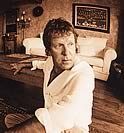The name Keith Emerson is synonymous with a more effervescent style of musicianship. First with fledgling prog-rockers, The Nice in the late '60s, and then with the monumental Emerson, Lake & Palmer in the '70s, he played keyboards like no one else. Often with knives stabbed into an instrument that had barely settled back onto its feet after being thrown about. Sometimes playing upside down or spinning above the audience, sometimes finishing a show with hands bloody from playing so hard, the occasional broken nose and broken ribs - all the mark of a man committed to putting on a real show.
It wasn't just the theatrics that impressed. His music fused rock and a multitude of styles, most notably with heavy classical leanings. The effect was to bring the focus for the first time in a rock band onto the keyboard. The first ELP single in 1970, Lucky Man, featured the startling new concept of a lead synth solo. It was a prelude to the band taking the world by storm, with a core of five platinum albums released between 1970 and 1974, and a host of successful solo works that continue today. In ELP's heyday, a hardcore following of prog-nuts were wowed by ever-increasing and outrageously expansive sets. The now infamous image of three huge personalised juggernauts thundering across the US highways, each emblazoned on the roof with one of the band-members' names, has entered the annals of rock excess.
For those who doubt his talent, Keith's musicianship is for real. Not just a rock star with a bit of spare talent, he has also performed as a bona fide instrumentalist with the London Symphony Orchestra, the Los Angeles Philharmonic and L'Orchestra d'Opera de Paris. counterculture caught up with Keith in his California home, one week before he flew back to England for rehearsals for the October UK-wide tour with The Nice, and the publishing of his memoirs, Pictures Of An Exhibitionist.
Before he'd even had his breakfast we were putting the questions to him that we hope give a brief insight into what makes a rock legend tick.  counterculture: Your performances have not just been about musicianship, but about being a 'showman'. Where did the flag-burning, knives and general Hammond organ abuse thing come from? counterculture: Your performances have not just been about musicianship, but about being a 'showman'. Where did the flag-burning, knives and general Hammond organ abuse thing come from?
Keith Emerson: Basically it comes from the fact that guitar players were the most mobile musicians on the stage and it's very difficult to make a 350lb Hammond part of you. That part of the act was something that just felt natural to do; something that allowed me be more expressive. I learned some of it from watching the likes of Pete Townsend . . . maybe he's not a good name to mention at the moment? But also of course Hendrix. cc: You weren't worried about stabbing an electric instrument with long metal blades? KE: I didn't bother about that sort of thing then . . . cc: So do you think this is part of what Beethoven meant by great music happening between the notes - I don't mean the knives between the keys, but the passion and involvement that makes music rather than sound? KE: Yeah, well you tapped it there. John Coltrane the jazz tenor player used to create walls of sound and just, well, play between the notes. That's what I hope I do. cc: Are you going to be getting into any keyboard abuse in your new shows? KE: I don't know, I may get into trashing instruments again, but the instrument I used to do that on they don't make anymore - so maybe its not such a good idea! |